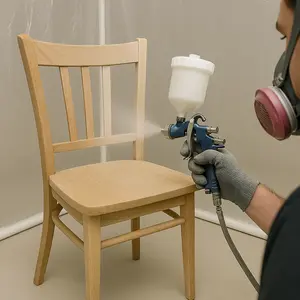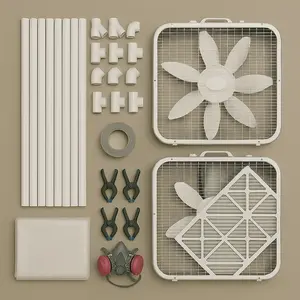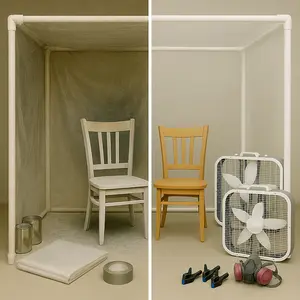Spray painting can give your projects a professional, smooth finish, but without the right setup, overspray, fumes, and dust can ruin the result. That’s where a spray paint booth comes in. The good news? You don’t need to spend thousands on a commercial setup. You can learn how to make a DIY spray paint booth right in your garage or workspace with affordable materials.
In this guide, we’ll cover DIY spray booth plans, safety tips, airflow design, and how to build a booth that keeps your projects clean and your lungs safe.
Why Build a DIY Spray Paint Booth?
Before diving into the DIY paint booth plans, let’s understand why a booth is so important:
- Cleaner Finish: Dust-free, consistent airflow keeps your paint jobs smooth.
- Controlled Overspray: Prevents paint particles from coating everything in your garage.
- Health & Safety: Reduces harmful fumes with proper ventilation.
- Cost-Effective: A booth you build yourself costs a fraction of a commercial one.

If you’re planning a home renovation, furniture makeover, or even art projects, a spray booth makes a huge difference. You might also want to check out how to clean walls before painting to ensure the best results before you start spraying.
Planning Your DIY Spray Paint Booth
Every great booth starts with a good plan. Here are the key things to consider before building:
- Space Available: Garages are popular because they allow for easy airflow. A DIY paint booth for garage projects should fit comfortably while leaving room for movement.
- Size of Projects: Decide whether you’ll be spraying furniture, car parts, or smaller items.
- Budget & Materials: You can choose between basic plastic sheeting and frames or upgrade with a garage paint booth kit for a sturdier build.
- Ventilation Needs: Strong airflow ensures fumes don’t linger indoors.
For inspiration on painting finishes, you can also explore the best ceiling paint color if you’re planning large interior projects after building your booth.
Materials You’ll Need
Here’s a simple list to get started:
- PVC pipes or wood for framing
- Heavy-duty plastic sheeting or tarps
- Box fans or inline ventilation fans
- High-quality air filters
- Duct tape, clamps, or zip ties
- LED shop lights (optional for visibility)

Pro Tip: If you want a ready-to-assemble option, a garage paint booth kit can save time, but building your own gives you more flexibility.
Step 1: Setting Up the Frame
The first step in your DIY spray booth plans is building a frame. PVC piping is the most common choice because it’s lightweight, easy to cut, and inexpensive.
- Cut PVC pipes to create a cube-like structure.
- Assemble with elbows and T-joints for stability.
- Make sure the frame is tall enough to stand in and wide enough to move around comfortably.
If you’re spraying larger surfaces like ceilings or panels, you might find tips from the best way to paint a ceiling helpful in planning your project.
Step 2: Adding Plastic Sheeting
Once your frame is built, cover it with heavy-duty plastic sheeting:
- Attach with clamps or duct tape along the frame.
- Leave a flap for a door to enter and exit easily.
- Seal edges tightly to avoid leaks and dust intrusion.
This step transforms your frame into an enclosed booth. If you’re working in high-moisture areas like bathrooms or kitchens later, also see the best paint for bathroom ceiling to prevent mold.
Step 3: Designing Airflow & Ventilation
Airflow is critical in a spray booth. Poor ventilation can leave fumes hanging and ruin paint finishes. For proper garage paint booth design:
- Place box fans at the back of the booth to pull air out.
- Tape furnace filters over fans to catch paint particles.
- Open a filtered air intake on the opposite side for clean airflow.
This cross-ventilation ensures a safe and dust-free environment. If you’re working on wood projects, knowing the best paint to use on wood can help after your booth is ready.
Step 4: Lighting the Booth
Good visibility is essential. Spray painting in low light can lead to uneven coats.
- Install LED shop lights overhead or along the sides.
- Avoid halogen lights, as they can heat up the plastic sheeting.
- Ensure wiring is safe and away from paint mist.
Step 5: Safety First
When you make your own paint booth, don’t forget about safety. Always:
- Wear a respirator rated for paint fumes.
- Keep a fire extinguisher nearby.
- Avoid open flames or sparks near the booth.
- Dispose of used filters properly.
For faster results, you can also explore how to make paint dry fast after your project.
Alternative: Buying a Garage Paint Booth Kit
If DIY isn’t your style, you can purchase a garage paint booth kit. These kits often include:
- Inflatable or collapsible frames
- Built-in filters and fans
- Quick setup features
While more expensive, kits can save hours of assembly and guarantee safety-tested designs.
Tips for Maintaining Your DIY Spray Booth
To keep your booth effective over time:
- Replace filters regularly to maintain airflow.
- Clean plastic sheeting of overspray after major projects.
- Check for leaks in seams and reseal with duct tape if needed.
If you’re working on home improvement projects, you may also want to read about the benefits of painting your home to maximize the impact of your work.
DIY Spray Booth Plans for Small Projects
If you don’t need a full garage setup, you can also make your own spray booth for smaller projects like models, crafts, or art pieces:
- Use a cardboard box lined with plastic.
- Add a small desk fan with a filter for ventilation.
- Keep it on a sturdy table for accessibility.
This is an affordable solution if you don’t have room for a full DIY spray paint booth.
Garage Paint Booth Design Mistakes to Avoid
When planning your booth, avoid these common errors:
- Improper airflow: Fans without filters just spread paint particles.
- Too small a space: You need room to move and spray evenly.
- Cheap lighting: Poor lighting leads to uneven coats.
- Skipping safety gear: A respirator isn’t optional—it’s essential.

For painting ceilings or walls afterward, you can also find tools like the best paint edging tool to finish clean lines outside your booth.
Final Thoughts
Building your own spray booth is an empowering project. With basic tools and affordable materials, you can make your own spray booth that rivals professional setups. Whether you’re painting furniture, home decor, or even auto parts, a booth ensures safety, cleaner results, and less mess in your workspace.
If you’re ready to take your painting projects to the next level, follow these DIY spray booth plans and start experimenting with your next masterpiece

Leave a Reply